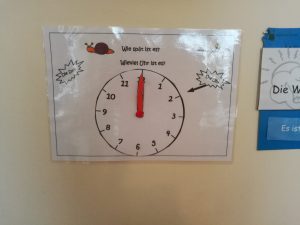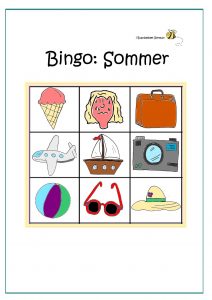Language learning activities
Sometimes it is difficult to come up with new language learning activities for your language lessons at home or in school. What you will find here is a little collection of activities that are suitable for language classes for children.
This list for language learning activities is always going to be extended. Please check for updates.
Other language learning activities can be found here.
“Ich packe meinen Koffer und ich nehme…………..mit.”
“I pack my suitcase and I bring (take)………with me.”
Suitable for children from the age of 3 onwards.
Group size: 2-10 children
Learning outcome: New nouns
This activity is absolutely perfect for the holiday season. You could put an actual suitcase on the table/ floor and the children have to put items such as sunglasses/ trousers/ sun cream into the suitcase.
The first child could say “Ich packe meinen Koffer und ich nehme Schuhe mit.” (I pack my suitcase and I bring shoes.”) The second child has to repeat the first item and add another. Example: “Ich packe meinen Koffer und ich nehme Schuhe und eine Zahnbürste mit.” (“I pack my suitcase and I bring shoes and a toothbrush.”)
And so it goes on and on until the children mix up the order or forget items.
After playing this game we went on to create a little display. The children had to draw and name the items. We haven’t finished it yet but this is how it looks like at the moment:

“Wie spät ist es Herr Wolf?”
“What time is it Mr Wolf?”
Suitable for children between the ages of 3 and 12.
Group size: From 3 children
Learning outcome: Telling the time
One child has to be the wolf in this game.
The other players stand on one line and ask: “Wie spät ist es Herr Wolf?”. (“What time is it Mr Wolf?”) The wolf could answer: “Es ist drei Uhr.” (It is three o’clock).
Then the children have to take three steps towards the wolf. The aim of the game is to catch/touch the wolf before the wolf is going to start his hunt. The wolf is allowed to call out “Essenszeit!” (“Dinner time!”) at any stage during the game. The wolf then turns around and catches as many children as possible before they step over the line. Once they step over the starting line, they are save again. It is a fun game that can be played outside but also inside.
I put this little clock up in my classroom. It helps the children to memorise how to tell the time in German. You can find it in the printouts section.

“Ich sehe was, das du nicht siehst und das ist…”
I see something that you do not see and that is”
Suitable for children of all ages.
Group size: From 1 child
Learning outcomes: colours, shapes, nouns.
One child finds an object in the room and says: ” Ich sehe was, das du nicht siehst und das ist…..”. Now the object has to be described. For example: “Ich sehe was, das du nicht siehst und das ist blau und rund.” (I see something that you do not see and that is blue and round.”) The other children or the teacher have to guess what it could be. “Ist es dieser Ball?” (“Is it this ball?”) More and more characteristics of the object can be added until the correct item has been found. Example: ” Ich sehe was, das du nicht siehst und das ist blau, rund und groß.” (“I see something that you do not see and that is blue, round and big.”
Dance/ Song: “Komm lass uns tanzen.” “Come on, let’s dance.”
Suitable for children from the age of 3.
By the way, “Kika” is a popular children’s channel in Germany. The lyrics are a little bit more complex so language learning activities like this might not be suitable for beginners but the actual dance/ movements are great fun.
“Hände waschen”
“wash your hands”
Suitable for children from the age of 2.
Learning outcome: New nouns and phrases.
Lyrics:
Hände waschen, Hände waschen muss ein jedes Kind
Hände waschen, Hände waschen bis sie sauber sind.
Nun sind die Hände sauber, ja
Doch leider ist kein Handtuch da.
Drum müssen wir sie schütteln,
schütteln, schütteln, schütteln,
Drum müssen wir sie schütteln,
Bis dass sie trocken sind.
….
Every child should wash their hands, wash their hand
wash their hands until they are clean.
Now the hands are clean, yes
but there is no hand towel.
Then we’ll need to shake them,
shake them, shake them, shake them,
Then we’ll need to shake them
until they are dry again.
Subsitute Hände with Haare (hair) and Füße (feet).
The children make corresponding movements to the lyrics.
Rallye
Suitable for children of all ages. This is a great competitive game, especially when you are teaching a large group of children. The learning outcome depends on the teacher’s preferences.
At different locations in the classroom, assignment notes (for example, word lists with omitted letters, error texts, memory games) are set up. The students go in small groups from assignment to assignment. The (fastest) group with the correct answers wins.
Letter museum
Suitable for children from the age of 3.
Learning outcome: Alphabet, new nouns.
Set up “letter” boxes in your classroom. Example: In the letter box for “A” the children have to put objects that begin with the letter “a” such as a toy monkey (der Affe) or car (das Auto). At the end of the week the teacher checks the boxes and talks about the various objects or asks question. Example: “A wie Auto. Welche Farbe hat das Auto?” (C as in car. What’s the colour of the car?)
Sommer Bingo

This is a great language learning activity for the summer. There are also other Bingo Games available. Click here to download the Sommer Bingo Game.
Materials: For this activity, I use my Sommer Bingo Game. As I would like to use it repeatedly, I laminated it.
Core content: Each child gets a “Legetafel” (a Bingo board). The kids have to either describe the pictures on the cards or guess the nouns. When they guess correctly, they receive the card and put it on their Bingo board. The child with the most cards at the end of the game wins.
Linguistic focus: New vocabulary, simple questions and answers, descriptions of pictures, adjectives. The question “What is that?” and the sentences “This is a / e ……” as well as “What does it mean?” And “That means it is … … is.” are used repeatedly. In German: “Was ist das?” “Das ist ein/e…..” “Was bedeutet das?” “Das bedeutet es ist…..” Thus simple sentence structures are practised. The correct articles also have to be used (mainly undefined articles.)
At first I showed the children the pictures and practised the pronunciation of the nouns. After a test run, a competition took place. This is of course not necessary but the children usually enjoy it. The child, who first exclaims the correct sentence and the correct word, gets the card and puts it on the bingo board. The child with the most cards wins.
